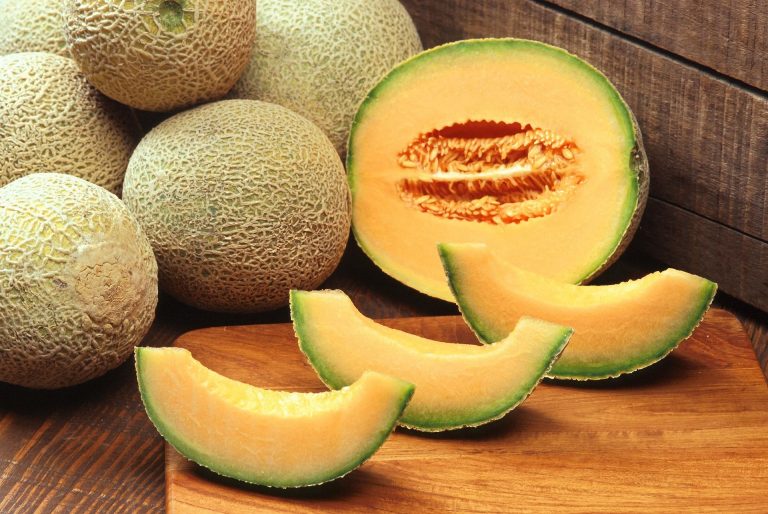The Allure of Cantaloupe: Botanical Insights, Culinary Joys, and Health Advantages
Introduction
Cantaloupe, scientifically known as Cucumis melo var. cantalupensis, is a beloved summer fruit cherished for its sweet, juicy flesh and refreshing flavor. Belonging to the Cucurbitaceae family, cantaloupe is widely cultivated in warm climates around the world, including regions of Europe, Africa, Asia, and the Americas. This article offers an in-depth exploration of cantaloupe, encompassing its botanical characteristics, nutritional profile, culinary versatility, and potential health benefits.

Botanical Characteristics and Varieties
Cantaloupe is characterized by its round to oval shape, netted or ribbed outer skin, and vibrant orange flesh with a sweet, musky aroma. The fruit typically weighs between 1 to 3 kilograms and is harvested when fully ripe to ensure optimal flavor and texture. Cantaloupe vines are sprawling and produce large, lobed leaves that provide ample shade and support for developing fruits.
There are several recognized varieties of cantaloupe, each distinguished by subtle differences in size, shape, and flavor:
- European Cantaloupe: Known for its smooth, ribbed skin and moderately sweet flavor. Varieties such as Charentais are prized for their delicate, aromatic flesh and are popular in Mediterranean cuisines.
- North American Cantaloupe: Commonly referred to simply as “cantaloupe” in the United States, these varieties feature thick, netted skins and firm, juicy flesh. They are widely cultivated across California and other warm, sunny regions.
- Asian Cantaloupe: Varieties such as the Japanese Makuwa melon are celebrated for their exceptionally sweet, crisp flesh and are often enjoyed fresh or in desserts.
Each variety of cantaloupe offers unique characteristics that cater to different culinary preferences and regional traditions.
Cultural Significance and Historical Uses
Cantaloupe has a rich history dating back thousands of years, originating in ancient Persia (modern-day Iran) and subsequently spreading to Europe and beyond through trade routes. The fruit’s name is originated from the Italian papal town of Cantalupo, where it was cultivated from the Renaissance era. Cantaloupe became a symbol of luxury and refinement in European courts, prized for its succulent flesh and delicate sweetness.
In addition to its culinary appeal, cantaloupe holds cultural significance in various societies:
- Mediterranean Traditions: In Mediterranean cuisines, such as in Italy and France, cantaloupe is often paired with prosciutto or served as a refreshing dessert with a sprinkle of mint or a drizzle of balsamic vinegar.
- Festivals and Celebrations: In some cultures, cantaloupe is featured in summer festivals and agricultural fairs, celebrating the harvest season and showcasing locally grown produce.
- Symbolism: Cantaloupe is associated with vitality, rejuvenation, and abundance, reflecting its status as a seasonal fruit heralding the arrival of summer’s bounty.

Botanical Features and Growth Requirements
Cantaloupe thrives in warm, sunny climates with well-drained soil and ample water supply. The vine-like plant requires sufficient space to spread and grow, often benefitting from trellising or support structures to promote airflow and fruit development. Cantaloupe flowers are bright yellow and appear on new growth, attracting pollinators such as bees and butterflies.
The fruit develops over several weeks, transitioning from green to yellowish-tan as it matures. Harvesting cantaloupe at the peak of ripeness ensures optimal flavor and sweetness, as the fruit does not ripen further once picked.
Nutritional Composition and Health Benefits
Cantaloupe is celebrated not only for its sweet flavor but also for its nutritional richness. A typical serving of cantaloupe (about 177 grams or 1 cup diced) provides:
- Calories: Approximately 60 kcal
- Carbohydrates: Around 15 grams
- Fiber: Roughly 1.6 grams
- Vitamin C: A significant amount, contributing to approximately 67% of the daily recommended intake
- Vitamin A: Essential for vision health and immune function, provided through beta-carotene, which the body converts into vitamin A
- Potassium: Important for healthy heart, function of muscles, and fluid balance
Cantaloupe’s high water content (about 89%) contributes to its hydrating properties, making it a refreshing choice during hot weather. The fruit’s combination of vitamins, minerals, and antioxidants supports overall health and well-being, with potential benefits including:
- Hydration: The high water content of cantaloupe helps maintain hydration levels, particularly important during hot weather or physical activity.
- Immune Support: Vitamin C and other antioxidants in cantaloupe support immune function, helping to protect against infections and promote wound healing.
- Digestive Health: Dietary fiber in cantaloupe promotes digestive regularity and supports a healthy gut microbiome.

Culinary Uses and Flavor Profile
Cantaloupe is primarily enjoyed fresh and can be incorporated into a variety of dishes, both sweet and savory:
- Fresh Consumption: Sliced or cubed cantaloupe is a popular addition to fruit salads, smoothies, and yogurt parfaits. Its sweet, juicy flesh pairs well with other fruits such as berries, pineapple, and citrus.
- Chilled Soups and Appetizers: Pureed cantaloupe makes a refreshing base for chilled soups or appetizers, often enhanced with herbs, spices, or a splash of citrus juice.
- Desserts: Cantaloupe is used in desserts such as sorbets, granitas, and fruit tarts, showcasing its natural sweetness and vibrant color.
- Savory Dishes: In Mediterranean cuisines, cantaloupe is occasionally paired with salty or savory ingredients like cured meats (e.g., prosciutto), cheese, or fresh herbs to create contrasting flavors and textures.
- Beverages: Cantaloupe juice or smoothies are popular beverages, offering a naturally sweet alternative to sugary drinks.
Practical Applications and Culinary Innovations
Beyond its traditional uses, cantaloupe has been explored for its culinary versatility and potential applications in:
- Preservation: Cantaloupe can be preserved through freezing, drying, or canning, extending its shelf life and availability beyond the growing season.
- Ingredient Pairings: Chefs and food enthusiasts experiment with cantaloupe in innovative recipes, blending it with herbs, spices, and other ingredients to create unique flavor profiles.
- Nutritional Supplements: Cantaloupe extracts and supplements are studied for their potential health benefits, particularly in promoting skin health, immune function, and overall well-being.

Global Production and Economic Impact
Cantaloupe production is significant in regions with favorable growing conditions, including the United States (particularly California), Mexico, Spain, China, and Central America. The fruit’s economic impact extends to agricultural exports, local markets, and food processing industries, where it is valued for its marketability and consumer demand.
Improved farming techniques, irrigation methods, and pest management practices support sustainable cantaloupe production, ensuring high-quality fruit for domestic consumption and international markets.
Challenges and Sustainability Practices
While cantaloupe is celebrated for its flavor and nutritional benefits, challenges in cultivation and sustainability include:
- Water Management: Cantaloupe requires adequate water supply for optimal growth and fruit development, prompting initiatives for efficient irrigation systems and water conservation practices.
- Pest Control: Effective pest management strategies are essential to mitigate risks from insects and diseases that affect cantaloupe crops.
- Environmental Impact: Sustainable farming practices, such as crop rotation, soil conservation, and integrated pest management (IPM), promote environmental stewardship and long-term viability of cantaloupe production.
Future Directions and Conclusion
Cantaloupe remains a staple in global cuisine, valued for its sweet flavor, nutritional benefits, and culinary versatility. As consumer interest in healthy eating and exotic fruits grows, the demand for cantaloupe and its diverse applications is expected to expand.
Future directions in cantaloupe research and cultivation may focus on:
- Genetic Diversity: Developing new varieties with enhanced flavor, disease resistance, and adaptability to diverse climates.
- Nutritional Research: Further exploring the health-promoting properties of cantaloupe, including its potential role in preventive nutrition and dietary therapies.
- Sustainable Practices: Implementing sustainable agriculture practices to reduce environmental impact, conserve natural resources, and support resilient farming communities.
In conclusion, cantaloupe exemplifies the intersection of culinary delight, nutritional richness, and cultural heritage. Its botanical characteristics, health benefits, and versatile culinary uses underscore its role as a cherished fruit in global markets and culinary traditions. As we continue to appreciate and innovate with cantaloupe, its enduring appeal as a symbol of summer freshness and vitality remains a testament to nature’s bounty and human creativity in harnessing its gifts.

